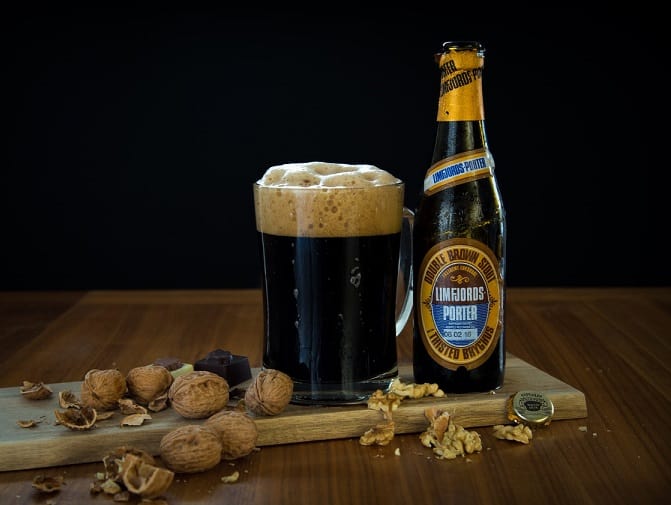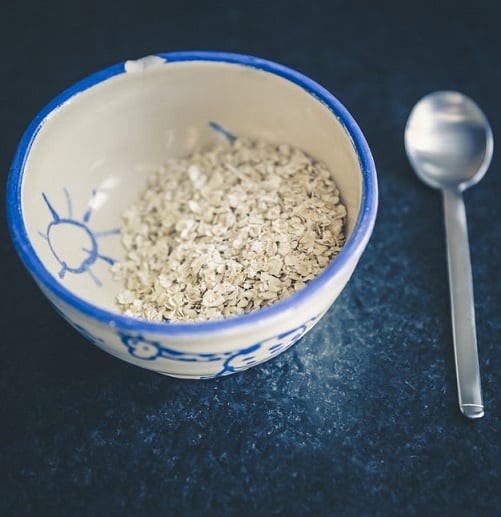
I’m a fan of the creamy sweetness of a fine oatmeal stout. Dark beers are some of my favorite, stouts especially. But it seems lately stouts have been overshadowed by popular hazy trends.
Before we get started what makes an oatmeal stout?
An oatmeal stout must be dark in color. The head retention must be long lasting and thick, from the addition of oats. It has a nutty flavor, but often not from oats themselves, but rather toasted malt. The dark roasted malts add a coffee like complexity. It should have a soft creamy mouthfeel.
So if you are longing for a delicious stout, why not try making your own. Below I guide you through making your very own oatmeal stout from scratch.
A Bit of History
Oatmeal stouts were marketed as a form of elixir throughout its early history. It was born in England and the addition of oats gave it its medicinal properties.

There is also some confusion about whether a stout or porter is actually the same thing. I don’t pretend to know the main difference between the two other than a porter is typically just a bit sweeter.
The Grain Build and Variations
Oatmeal stout by virtue of its lean towards darker and roastier malts makes it a bit more difficult to brew. But than never stopped us from taking the plunge, and it shouldn’t stop you either!
Interestingly enough, oats only make up a small portion of the overall grist.
Typically. (There may be some outliers).
I mean why not add more, wheat beers have 50 percent of their grist as wheat. But, to stay true to the dark delicious brews we will stay on course for this one.
It may be easier to make a simple Irish stout, (since there are fewer ingredients) but we want to make something bolder, and full of flavor.
And something that well, makes us think of breakfast.
Oats and Their Affect on Beer
Why is it called an oatmeal stout if there are so few oats?
Well, its likely the mouthfeel. While oats can contribute little to the overall flavor of the beer it does create a very pleasant and creamy mouthfeel.
I mean when was the last time you added water to your morning rolled oats and actually enjoyed the flavor.

Never. You added fruits, sugar, and most likely milk!
Tip: Instead of buying flaked oats from a homebrew supplier you can actually buy quick oats from the store. It could be cheaper!
So now that we know oats typically don’t add much to the beer other than mouthfeel. (also protein and head retention). Next, we need to figure out what the grain bill should look like.
Base Malt and Specialty Malt
To get started lets see what is typically the base malt for an oatmeal stout. I’ll give you a hint, its not oatmeal.
If you said, pale malt, you get an oatmeal cookie!
You can find Briess pale ale malt and Viking 2-Row pale malt at MoreBeer.com.
Crystal or Caramel malts are a popular specialty malts. As is the addition of chocolate malt.
While you can add tons of different specialty malts to an oatmeal stout, as always with your first brew its best to stick with a few trusted malts. That way you don’t create a malt cocktail of unknown consequence.
In order to get the dark color often associate with stouts and oatmeal stouts we need to make sure we target malts with higher lovibond levels.
The addition of chocolate malt is a good way to darken the brew.
Grain Bill Percentages
You can tinker with the percentages however you like, but as a base you typically want the following percentages.
- 65-70% base malt
- 15-20% flaked oats
- 10-15% specialty malt (target darker malts)
Tip: If you decide to go above 20% flaked oats or even if you have trouble with a stuck mash, add rice hulls. This will be an addition that should not be added to your overall grain bill percentage, since it adds no fermentable sugars.
If you are unsure how to do an all-grain brew check out my article on getting started with all-grain brewing.
One thing to note about brewing an oatmeal stout is the mash temperature. It should be a on the higher side from 154F-156F.
This will produce sugars tougher for yeast to eat resulting in a full bodied and sweeter beer.
The Most Common Hop Types
When it comes to hops in an oatmeal stout you need it to stand up against the strong flavors that stouts exhibit.
The roasted caramel chocolate flavor can be difficult to overcome so make sure you hit a target IBU to counteract the sweetness.
As an alternative, if you are going for more of a desert beer than IBU’s don’t become as important. But, it can sometimes be difficult to drink an entire pint of a super sweet stout.
Bittering Hops
When it comes to bittering hops almost anything will do. I would lean towards cleaner hop flavors and aroma so nothing but the bitterness cuts through.
Also make sure you choose cheap hops to add when you are bittering. No need to buy expensive flavorful hops that you wont taste.
Some examples of bittering Hops to use are below.
- Magnum
- Millennium
- Columbus
Again make sure you use any hops that are cheaper in price and classified as a bittering hop. You can also use hops that you have extra, but don’t plan on using before they go bad.
Flavor and Aroma Hops
I always advocate complimenting the beer style with flavor and aroma hops. One way to do this would be adding a citrus note to a heavy chocolate malt recipe.
However, sometimes is just best to keep the hops in the background and let the malt shine as the hops play a supportive role.
| Hop Name | Flavor Profile | Supporting Style |
|---|---|---|
| Cascade | Grapefruit citrus flavor, so gives a nice bitterness | Also good for bittering since its so cheap. |
| Goldings | Citrus and Spicy. Complimenting of malt flavors | Supports the malt but gives it a nice citrus kick. Citrus flavor is more of a lemon |
| Fuggle | Earthy, Grassy Flavor | Best for Supporting Malt Character. Coffee and Soft Bitter Notes. |
Make sure you are keeping the IBU’s low. Something like 25 IBU’s are a good place to be at. Whether its adding the hops at the beggining or the end of the boil, make sure you hit the right IBU.
You can do this by checking out some IBU calculators by typing that into google.
Steps During the Boil
When it comes to the boil, oatmeal stouts are just like any other beer. You will typically do a 60 minute boil, with hop additions throughout.
Tip: Brewing an oatmeal stout as an all-grain makes sense since there is a high degree of specialty malts. Its also a great way for extract brewers to begin grain experimentation.
Depending on what IBU’s you are shooting for you will be adding some hops at 60 minutes and then the remainder at 5-15 minutes.
Its also at this point where a lot of brewers like to play around with some adjunct spices.
I’m leaving most of the steps during the boil open to interpretation, since if you are following a specific recipe it will let you know. If you are interested in learning more about the process check out beerandbrewing’s process recommendation. What I will say is that most of your adjunct additions should take place at the end of the boil, with only bittering at the beginning.
A clarifying agent of Irish moss can be added at 15 minutes to the end of the boil. It might not make sense to add a clarifying agent to such a dark beer, but if you look through the glass in the light, you will see clarity instead of gunk.
Because even though they look black as night, they are in a reality a dark amber.
Oatmeal Stout Adjuncts

When it comes to darker beers there is a whole new realm of possibilities when it comes to adding additional ingredients. Most if not all can be added during the boil.
You will typically want to add these adjuncts near the end of the boil to avoid a cooked taste but you can add them throughout and experiment to your hearts content.
What brewers are trying to emulate is a delicious bowl of warm morning oatmeal so below are some common oatmeal stout adjuncts.
- Lactose in order to achieve the milk in oats taste.
- Cinnamon and brown sugar.
- Coffee Beans (because of course you drink coffee with breakfast).
- Chocolate
- Berries of all kinds (raspberry, blueberry, and blackberry are some examples).
This is by no means an exhaustive list of interesting ingredients you could add to an oatmeal stout, just off the top of my head a banana and orange sound like they could be viable as well.
Tip: Don’t let fear of failure ruin experimentation. You will make beer and it will taste delicious (to someone at least) unless you don’t keep up sanitation.
Check out my article on how to add banana flavor to beer if you are interested in adding that to your stout.
Yeast for an Oatmeal Stout
When it comes to yeast in an oatmeal stout you want a clean finish. Esters are not the main event for stouts, but rather as is the theme throughout the article, malt makes a stout.
Check out the list below to get a better idea of common stout yeasts.
| Yeast Name | Style and Character | Fermentation Difficulty |
|---|---|---|
| 004 Irish Ale | Dry finish that promotes roasty malt notes. Makes a soft drinking stout. Lower preferred fermentation temperature. | Difficult since fermentation temperature is below room temperature. Also hard to clear. |
| 002 English Ale Yeast | Promotes malt character but has some mild fruity complexity. | Colder fermentation temperature but high flocculation keeps beer clear. |
| 023 Burton Ale Yeast | Subtle fruity ester profile. Leaves beer a bit cloudier. | Easy to ferment with since it is more at room temperature. |
| 013 London Ale Yeast | This one is for dark malty beers, specifically porters which are super sweet. So it should work well with a stout. pushes hop bitterness. | Fermentation temp is OK and flocculation is medium. |
Overall if you can get away with it I would go for the Irish ale yeast. It needs to ferment much colder, so you need to be able to cool it below room temperature.
If you don’t have a fermentation chamber, then the next best might be the London ale yeast.
Tip: Fermentation should begin when the cold hits in fall and the stout should be enjoyed through winter. This way you can forgo a fermentation chamber
I’ve only listed liquid yeast styles from white labs you could find that there are better yeasts for this style from either wyeast, or even experiment with different dry yeasts.
Many famous breweries have house yeast for their yeast forward beer such as a Belgian. But when it comes to stouts in particular the yeast just needs to be clean and let malt character shine.
Fermentation Temperature and Length
When it comes to fermentation temperature it will really depend on the style of yeast that you are using. Temperature does tend to range on the lower side though.
If you are brewing in the summer and have no way to cool your fermentation down it may be best to skip this beer until winter. Since you will need sub 70 Fahrenheit temperatures.
You should not need more than two weeks in primary for this beer and after primary you can just bottle the beer and let it get carbonated.
If you want to try out some different styles and adjuncts then you can go into a secondary phase. In the secondary phase make sure your ingredients are sterile, since oatmeal stouts tend to be lower in alcohol content.
Tip: Experiment with secondary fermentation. In the adjuncts section I listed off tons of ways to make your beer different. You can add them to secondary but split a 5 gallon batch into 5, one gallon batches to experiment.
There is really no need to do a secondary if you have added your flavor to primary. Some people like to do it to help clarity in the beer but its too much work and extra costs for a simple homebrew.
If you are interested in playing with secondary and fruits you can check out my article on secondary fermentation and flavors.
Carbonation and Oatmeal Stouts
When it comes to stouts a light creamy mouthfeel is your best bet. This will bring to the forefront the creaminess of the oatmeal. But what is the best way to do this?
Well if you didn’t know already its nitrogen carbonation. The Nitro keg carbonation makes the beer much softer and plays to the strength of the oatmeal.
While you can get a nice creaminess from normal CO2 it will have more of a bite.

Since its difficult for a homebrewer to replicate the nitro bottle process, you would be better off kegging a stout. Thats not to say you can’t bottle a stout just fine though.
If you wish to bottle your stout go about it the same way you would any other bottling.
Tip: If you have a big beer you may want to give it more time in the bottle to carb up.
Two weeks in the bottle should be enough for a lighter oatmeal stout, but try it out to see if you want it to carb longer before cold crashing to stop the yeast.
